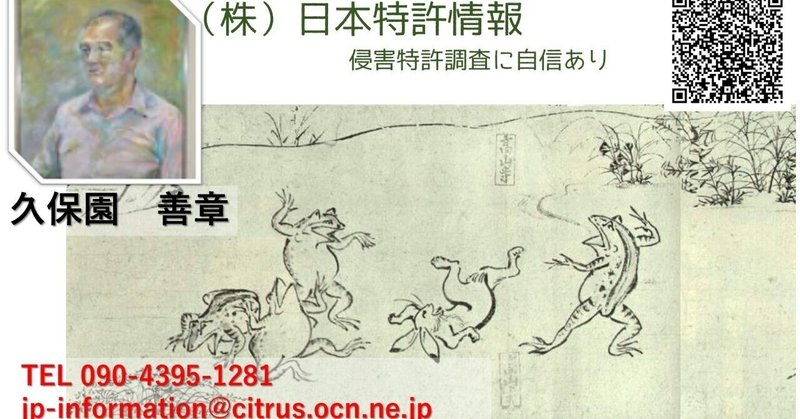
原告の請求棄却(原告=ジュピターの権利無効)。 東京地方裁判所により「権利無効」とされた新96件目のものです。
https://drive.google.com/file/d/1H2YYyuutRLT9r3sJw6MB1jt-VZ0Rn2f7/view?usp=sharing
特許権者である原告のジュピター有限会社は、自分が保有する特許第5,133,797号(コンプレッションサポーター)について、その特許の「有効性」を検証したか不明です。
「有効性」とは、自社の特許についての、例えば「無効資料調査」等を行うことで、たとえ利害関係者などの第三者からの「無効審判」を起こされても、自社の特許は盤石であると確信することです。
それにも拘らず、ジュピター有限会社は、特許庁より与えられた特許を有効と信じて、興和株式会社を特許侵害している、と提訴しました。
しかしながら、東京地方裁判所は「本件発明は、特許法36条6項1号に違反し、特許無効審判により無効とされるべきものであるから、原告は、本件特許権を行使することができない。」とし、結局、原告は敗訴しました。
特許法36条6項1号は「サポート要件」違反です。
そして詳しくは、「本件明細書等によれば、本件発明は、一体編成・織成構造のサポーターが必要な押圧を欠くという課題を解決するものであるから、当該サポーターが本件発明の課題を解決し得ないことは、本件明細書等の記載からも自明であって、原告の主張は、採用することができない。」と述べています。
特許庁の審査官は、この「サポート要件」には関心がなかったようです。
特許庁段階においては、IPCCの検索者(KC2D)は指導者(L109)に「特開平03-254744号公報」と「特開2003-088544号公報」を「X文献」として提示しました。
一方、本件ターゲット特許(公開2010-013765)を審査した審査官(二ッ谷裕子9339)は、この内の「特開平03-254744号公報」を引用文献として、出願人にぶつけました。
出願人のジュピター有限会社は「手続補正書」を提出し、みごと「特許査定」を得て、特許権を勝ち取りました。
しかしながら、特許権利者は東京地方裁判所において上記のように敗訴しました。
本件の根本原因は、東京地方裁判所で示された「本件特許は特許法36条6項1号に違反する」との判断に、特許庁の審査官は思い至らなかった点にあります。
特許庁の審査官のいい加減な判断に基づいた、特許付与は許されません。
従って、本来なら、ジュピター有限会社の出願に対して、特許庁は特許を与えるべきでなかった、と考えます。
特許庁の審査官が、出願人のジュピター有限会社に特許を与えたことにより、以後の出来事が如何にネガティブな事態となって行ったかが理解できます。
「行政」(特許庁)としては、「司法」(裁判所)により誤りを指摘されたことを謙虚に反省し、その誤りを正すことを心掛けるべきです。
特に、審査官が登録調査機関の検索者を指導して作らせている「検索論理式」、又は自らが作成していると思われる「検索論理式」の作成を、根本的に改革すべきです。
なお、裁判過程において、被告人より提示された先行技術文献が3件あります。
「乙3発明」(欧州特許公開公報第600218号)、「乙4発明」(西ドイツ特許公開公報第3416231号)および「乙5発明」(スイス特許特許公報第657044号)です。
これら3件については、東京地方裁判所は先行技術文献であるかどうかの判断はしていません。
そして更には、これら3件の文献は、特許庁の審査段階では見つけることが出来ていません。
繰り返しになりますが、登録調査機関の検索者が作成する【検索論理式】の無茶苦茶さ、そして特許庁の審査官による、不十分な(サーチ)に基づいての、特許付与は許されません。
特許庁の審査官は、所謂(サーチ)ではない、正しい「先行技術調査」を学び直す必要があると思います。
ここで、本件特許公開の「出願情報」のうち「FI」と「Fターム」を、本エクセル資料の2シート目以降に挙げておきました。
更にまた、「検索用語・分類(FI、Fターム)の選定 と 検索論理式の作成」、「その具体例」、「登録調査機関の検索者が行った、不十分で、的外れな「論理検索式」による(サーチ)」、「登録調査機関(株式会社AIRI)の検索者が見つけることのできなかった特許文献」などの資料を添付します。
https://drive.google.com/file/d/1Q3hHuHFHCHNlr3A0CRYVKYfpiNTPWUjB/view?usp=sharing
(Google Translation)
Plaintiff's claim dismissed (plaintiff = Jupiter's rights invalidated).
This is the 96th new case that has been declared "invalid" by the Tokyo District Court.
It is unclear whether the plaintiff Jupiter Co., Ltd., the patentee, has verified the "validity" of its patent No. 5,133,797 (compression supporter).
"Validity" means that even if an "invalidation trial" is filed by a third party such as an interested party, the company's patent will remain valid by conducting, for example, "invalidation material investigation" regarding the company's patent.
Be sure that it is rock solid. Despite this, Jupiter Co., Ltd. believed that the patent granted by the Japan Patent Office was valid and sued Kowa Co., Ltd. for patent infringement.
However, the Tokyo District Court ruled that ``this invention violates Article 36, Paragraph 6, Item 1 of the Patent Act, and is subject to a patent invalidation trial.''
Therefore, the plaintiff cannot exercise the patent right. Can not.
In the end, the plaintiff lost the case. Article 36, Paragraph 6, Item 1 of the Patent Act violates the "support requirements." In detail, ``
According to the specification, etc., the present invention solves the problem that the supporter with an integrally knitted or woven structure lacks the necessary pressing force, so the supporter solves the problem of the present invention.
It is obvious from the statements in the specification of the case that this cannot be done, and the plaintiff's argument cannot be accepted."
The patent office examiner did not seem to be interested in this "support requirement."
At the Patent Office stage, the IPCC searcher (KC2D) presented the instructor (L109) with "JP-A-03-254744" and "JP-A-2003-088544" as "X Documents."
On the other hand, the examiner (Yuko Nitani 9339) who examined the target patent (Publication No. 2010-013765) cited "Japanese Unexamined Patent Publication No. 03-254744" as a cited document and pointed it at the applicant.
The applicant, Jupiter Co., Ltd., submitted a ``procedural amendment,'' successfully obtained a ``grant of patent,'' and won the patent right.
However, the patentee lost the case at the Tokyo District Court as described above.
The root cause of this case is that the examiner at the Japan Patent Office did not consider the decision made by the Tokyo District Court that ``the patent in question violates Article 36, Paragraph 6, Item 1'' of the Patent Act.
It is unacceptable to grant a patent based on the sloppy judgment of a patent office examiner.
Therefore, we believe that the Patent Office should not have originally granted a patent to the application by Jupiter Co., Ltd.
You can understand how negative things turned out to be after the patent office examiner granted the patent to the applicant, Jupiter Co., Ltd.
The ``administration'' (patent office) should humbly reflect on the fact that the ``judiciary'' (courts) pointed out an error, and strive to correct the error.
In particular, the creation of "search logical formulas" that examiners instruct searchers at registered search organizations to create, or that they appear to create themselves, should be fundamentally reformed. is.
There are three prior art documents presented by the defendant during the trial process.
These are the "Otsu 3 Invention" (European Patent Publication No. 600218), the "Otsu 4 Invention" (West German Patent Publication No. 3416231), and the "Otsu 5 Invention" (Swiss Patent Publication No. 657044).
Regarding these three cases, the Tokyo District Court has not determined whether or not they are prior art documents.
Furthermore, these three documents could not be found at the examination stage of the Patent Office. Once again, the granting of a patent based on the unreasonableness of the [search logical formula] created by the searcher of a registered search organization and the insufficient (search) by the patent office examiner is unacceptable. not.
I think examiners at the Patent Office need to relearn proper "prior art searches" rather than so-called (searches).
Here, the "FI" and "F-term" of the "application information" of the patent publication are listed in the second sheet and subsequent sheets of this Excel document.
Furthermore, we also provide information on ``selection of search terms and classifications (FI, F-terms) and creation of search logical formulas,'' ``concrete examples,'' and ``inadequate and irrelevant ``logical searches conducted by searchers at registered research organizations.''
Attach materials such as "(search) by formula" and "patent documents that the searcher of the registered research organization (AIRI Co., Ltd.) could not find."
(Google 翻译)
原告的诉讼请求被驳回(原告=木星的权利无效)。
这是东京地方法院宣布“无效”的第96起新案件。
目前尚不清楚专利权人原告木星有限公司是否验证了其第5,133,797号专利(压缩支撑器)的“有效性”。
“有效”是指即使利害关系人等第三方提出“无效审判”,通过对公司专利进行“无效宣告材料调查”等,该公司的专利仍然有效。坚如磐石。
尽管如此,木星株式会社仍认为日本特许厅授予的专利有效,并起诉兴和株式会社侵犯专利权。
然而,东京地方法院裁定“该发明违反专利法第36条第6款第1项,应接受专利无效审判。”
因此,原告不能行使该专利权。 不能。
最终,原告败诉。 专利法第三十六条第六项第一项违反“支援要件”。
详细地, “根据说明书等,本发明解决了具有一体针织或机织结构的支撑件缺乏必要的压力的问题,因此该支撑件解决了本发明的问题。
从案件说明书中指出不能这样做,原告的主张不能成立。” 专利局审查员似乎对这个“支持要求”不感兴趣。
在专利局阶段,IPCC检索员(KC2D)向指导员(L109)提交了“JP-A-03-254744”和“JP-A-2003-088544”作为“X文档”。
另一方面,审查目标专利(公开号2010-013765)的审查员(Yuko Nitani 9339)引用了“日本未审查专利公开号03-254744”作为引用文件并将其指向申请人。
申请人Jupiter株式会社提交了“程序修正案”,成功获得了“专利授权”,获得了专利权。
然而,如上所述,专利权人在东京地方法院败诉。
本案的根本原因是日本特许厅审查员没有考虑东京地方法院关于“涉案专利违反专利法第36条第6项第1项”的决定。
根据专利局审查员的草率判断来授予专利是不可接受的。
因此,我们认为专利局最初不应对Jupiter Co., Ltd.的申请授予专利权。
您可以理解,专利局审查员将专利授予申请人木星株式会社后,结果是多么负面。
“行政部门”(专利局)应该虚心反省“司法部门”(法院)指出的错误,并努力纠正错误。
特别是,审查员指示注册检索组织的检索员创建或他们似乎自己创建的“检索逻辑公式”的创建应该从根本上进行改革。
被告在庭审过程中出示了三份现有技术文件。
它们是“大津3发明”(欧洲专利公开号600218)、 “大津4发明”(西德专利公开号3416231)和“大津5发明”(瑞士专利公开号657044)。
对于这三起案件,东京地方法院尚未确定它们是否属于现有技术文件。
而且,这三份文件在专利局审查阶段并未查到。
再次强调,基于注册检索机构检索员创建的[检索逻辑公式]不合理以及专利局审查员(检索)不充分而授予专利是不可接受的。
我认为专利局的审查员需要重新学习适当的“现有技术检索”而不是所谓的(检索)。
这里,该专利公开的“申请信息”的“FI”和“F项”列在该Excel文档的第二页和后续页中。
此外,我们还提供有关“搜索术语和分类(FI、F术语)的选择以及搜索逻辑公式的创建”、“具体示例”以及“不充分且不相关的”由附上“通过式子进行检索”、“注册研究机构(株式会社AIRI)的检索者无法找到的专利文献”等材料。
(ハッシュタグ)
#INPIT #JPlatPat #仕事について話そう #note #note毎日更新 #note毎日投稿 #note連続更新 #note連続投稿 #noteクリエイター #note応援部 #note毎日 #note海外組 #noteメンバーシップ #note日記 #note更新 #noteサークル #仕事 #仕事のコツ #仕事のポリシー #仕事論 #仕事効率化 #仕事観 #仕事ができる人 #仕事の話 #仕事内容 #仕事の仕方 #仕事の進め方 #仕事を楽しむ #仕事とは #仕事力 #ビジネス #ビジネススキル #ビジネスモデル #ビジネスチャンス #知財 #知財戦略 #知財塾 #知的財産 #知的財産権 #知的財産高等裁判所 #特許 #特許調査 #特許法 #特許庁 #特許事務所 #特許分類 #特許検索 #特許分析 #特許情報 #特許権者 #特許無効審判 #専利 #分類付与 #先行技術調査 #無効資料調査 #侵害調査 #侵害予防調査 #パテント #発明 #発明塾 #どうする特許庁 #検索論理式 #審査官 #審判官 #AI #AIの活かし方 #AI画像生成 #IT #ITエンジニア #IT業界 #IT企業 #ITベンチャー #IT化 #IT系 #ITリテラシー #ITツール #DX #DX化 #DX推進 #DX人材 #DX事例 #DXリテラシー #Patent #ChatGPT #ChatGPTの使い方 #ChatGPTが凄い #ChatGPTに聞いてみた #Gemini #Threads #bing #bingAI #bingX #金子吉友 #一月万冊 #裁判所 #出願情報 #東京地方裁判所
この記事が気に入ったらサポートをしてみませんか?
